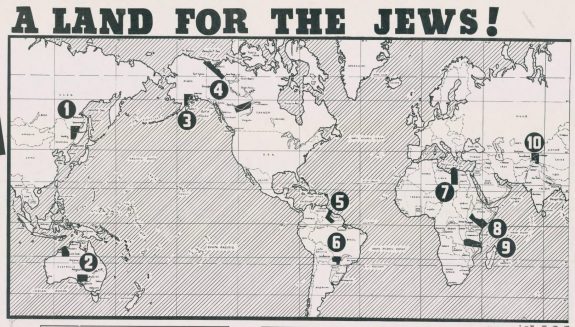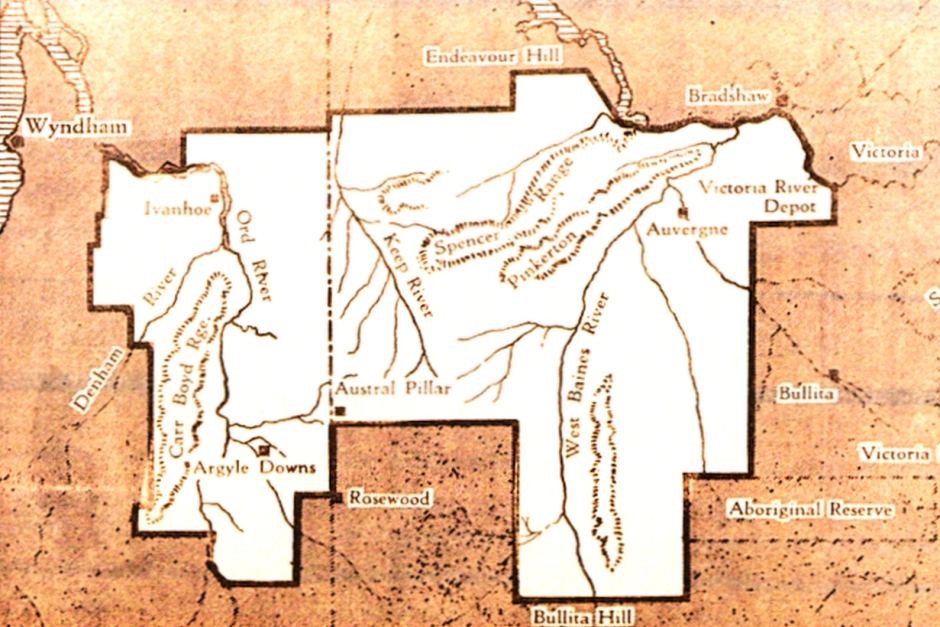The Kimberley Plan

By Dr George Venturini
The Kimberley Plan
Just before the outbreak of second world war, a bold plan was proposed by Dr. Isaac Nachman Steinberg, a man with a most interesting past: he was a Russian lawyer, and had been a Socialist Revolutionary, politician. He had been People’s Commissar of Justice in Vladimir Lenin’s government during the Bolsheviks’ short-lived coalition with the left wing of the Socialist Revolutionary movement. He was still a leader of the Jewish Territorialist movement and a writer – and subsequently in exile.
In 1939 the Freeland League for Jewish Territorial Colonisation, formed in the United States in July 1935 to search for a potential Jewish homeland and haven, identified the Kimberley in Western Australia as a place to resettle 75,000 European Jews fleeing rampant anti-Semitism.
The League was a non-Zionist organisation, and was headed by Dr. Steinberg.
The League sent a Yiddish poet and essayist Melech Ravitch to the Northern Territory in the 1930s to investigate the region and to collect data on topography and climate.
In late 1938 or early 1939 the pastoral firm of Mr. Michael Durack in Australia offered the League about 16,500 square kilometres in the Kimberley region in Australia, stretching from the north of Western Australia into the Northern Territory.
The League investigated the proposal, hoping to buy an area of 28,000 square kilometres of agricultural land for 75,000 Jews fleeing Europe. The tract in question was that of Connor, Doherty and Durack Limited, including Auvergne Station, Newry Station, and Argyle Downs, and extending between the Ord and Victoria Rivers.

Map showing the proposed settlement areas for the Kimberley Scheme. (Supplied by the Kununurra Historical Society)
Under the plan, an initial 500-600 pioneers would arrive to construct basic necessities for the settlement such as homes, irrigation works, and a power station, followed by the arrival of the main body of immigrants. Ravitch in his report to the League promoted a very large number, suggesting that the area could accommodate a million Jewish refugees.
The League sent Dr. Steinberg to lobby the Australian Government to accept the scheme. He arrived in Perth on 23 May 1939. An indefatigable publicist for the Kimberley scheme, he appealed to people both on humanitarian grounds but based his campaign on the officially declared need by Australia to populate northern Australia.
His proposal to the federal and state governments was “to open your gates to the persecuted Jewish people of Europe, and let them help transform the landscape into a productive agricultural hub.”
Dr. Steinberg’s vision, complete with the land’s new inhabitants “writing Jewish poetry about kangaroos and laughing kookaburras”, was embraced enthusiastically by many and gained the support of the then Western Australian Premier John Collings Willcock.
The scheme’s urgency was understood by many in Australia.
Government committees were looking at it, people mobilised in support of it, some churches campaigned for it, trade unions favoured it, and even businesspeople campaigned for it.
By early 1940 Dr. Steinberg had gained the support of major newspapers such as The Sydney Morning Herald, The (Melbourne) Argus and The West Australian.
But Dr. Steinberg also encountered opposition: from the Bulletin, Smith’s Weekly, some daily newspapers and several politicians, whose arguments ranged from the practical to the xenophobic and racist. For their part, many Australian Jews criticised the proposed settlement: some feared that it would provoke a wave of anti-Semitism in Australia, while others saw it as a threat to the Zionist cause.
Dr. Steinberg would leave Australia in June 1943 to rejoin his family in Canada.
A 1944 opinion poll found that 47 per cent of Australians opposed the scheme. Opposition was primarily based on concerns that the settlers would inevitably drift away from Kimberley and begin migrating to the cities in large numbers.
Despite sustained support for the Kimberley Scheme immigration programme from powerful sectors of the Australian community, it was eventually vetoed by the Federal Government.
On 15 July 1944 the scheme was vetoed by the Labor Government of John Curtin (1941-1945). Prime Minister Curtin informed Dr. Steinberg that the Australian government would not “depart from the long-established policy in regard to alien settlement in Australia” and could not “entertain the proposal for a group settlement of the exclusive type contemplated by the Freeland League.”
The Menzies Government (1949-1966) believed that the creation of “distinctive alien communities” would not be in the national interest.
A confidential Cabinet memorandum published on 19 May 1950, shows the Cabinet decided that: “The Commonwealth does not favour the settlement of any one area by a group of migrants as the establishment of an isolated community of migrants is contrary to the Government’s assimilation aims.”
The Menzies Cabinet blocked the Kimberly proposal, despite strong support from other quarters of the community.
Mr. Warren Austin of the Jewish Historical and Genealogical Society of Western Australia said such views were typical at the time.
“At that stage we had a White Australia policy and I think what the Government was interested in was having British stock coming here,” Mr. Austin said. “Of course, if it had gone ahead, a number of people’s lives might have been saved from the Holocaust because they would have come to Australia. I think that would be a fact.”
Though the immigration drive was never realised, many believe the proposal had a lasting impact.
Kununurra Historical Society member Mr. Andrew Barker said that Dr. Steinberg’s visit to the Kimberley region inspired the Durack family to increase their efforts to make the region agriculturally viable.
“The sort of stuff Steinberg would have been talking about, like cities of millions and dams and canning factories. This would have been enthusing Kim Durack,” he said.
“You could say that Steinberg enthused Kim Durack to start off what we have today as the Ord Scheme.”
Descendant of the Durack family, Ms. Perpetua Durack Clancy, said that Dr. Steinberg made a good impression on her family, who offered more than 27,000 square kilometres of leasehold land to the Freehand League.
Ms. Durack Clancy said her family supported the scheme going ahead.
“They [the Durack family] were ready for change. It had been a struggle for a long time and by 1939 the Depression that hit the Kimberley very heavily was just emerging.” she said.
Ms. Durack Clancy said the Kimberley region would be a very different place had the scheme gone ahead.
“Not only Australia but the whole of the Kimberley would have been different,” she said. (O. Gordon, ‘Israel in the Kimberley: How the Top End nearly became a global Jewish hub’, abc.net.au, 20 March 2018)
In 1948 Dr. Steinberg published a book on his experience. (I. N. Steinberg, Australia – the Unpromised Land: in search of a home, Gollancz, London 1948).
After the State of Israel was established in 1948 Dr. Steinberg tried once more – unsuccessfully – approaching the newly re-elected Robert Menzies in 1950. But Menzies replied that the idea ran contrary to his government’s policy of assimilation aimed at achieving “the ideal of one Australian family of peoples, devoid of foreign communities.” (A. Casey, ‘The Un-promised land’, Workers Online, 17 May 2002, Issue No. 136).
Dr. Steinberg died suddenly on 2 January 1957 in New York. His close friend Erich Fromm wrote: “Many people would have called Isaac Steinberg a dreamer, or a visionary, and yet, he was one of the true, and unfortunately few, realists of our time.” (B. Hooper, Steinberg, Isaac Nachman (1888-1957), Australian Dictionary of Biography, Volume 16, Melbourne University Press, 2002, at 298-299).
Continued Saturday – The HMT Dunera scandal (part 1)
Previous instalment – The Évian Conference
 Dr. Venturino Giorgio Venturini devoted some seventy years to study, practice, teach, write and administer law at different places in four continents. He may be reached at George.venturini@bigpond.com.au.
Dr. Venturino Giorgio Venturini devoted some seventy years to study, practice, teach, write and administer law at different places in four continents. He may be reached at George.venturini@bigpond.com.au.
Like what we do at The AIMN?
You’ll like it even more knowing that your donation will help us to keep up the good fight.
Chuck in a few bucks and see just how far it goes!










5 comments
Login here Register here-
New England Cocky -
David Bruce -
Michael Taylor -
Bronte ALLAN -
Return to home pagePerhaps you could also look into the proposal to have a Jewish homeland in SW Tasmania. This proposal lapsed when the Jewish forward scout died in the field. The Zeehan and Strachan Historical Societies may be useful sources.
Looking forward to the Dunera scandal in Sydney Harbour that Phillip Adams often speaks about on ABC RN.
Was there ever any serious consideration of a Jewish homeland, closer to Europe, around the current South East Ukraine and Northern Georgia?
David, looking at the map I’d say region 10 looks about the closest.
I have never heard of this proposal, however, what a complete difference it would have made to Australia, the people, our economy, our productivity, our ecology etc etc if this had come to fruition! Whilst not really in favor of a “separate” economy under Jewish jurisdiction in our land, the idea should/could have been instigated in the preceding years post WW2. This Kimberley etc area of Australia, already gets huge amounts of rain a year, with the majority, I imagine, flowing out to sea. Over many years, various proposals have been suggested about piping this water into the lower states etc. Why has no Government further investigated following up on this type of water saving idea? Makes some real sense to me! Couple this idea with a large “settlement” of Jewish–or other (non Middle East though!)–settlement in a large tract of this land mass, & we may have a further large agricultural area, much “extra” water supplies etc also.
Pingback: The HMT Dunera scandal (part 1) - » The Australian Independent Media Network